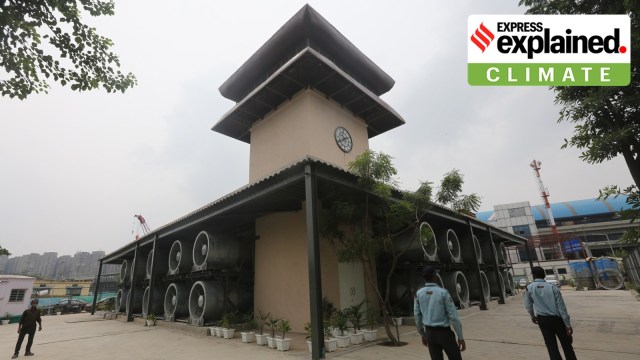Expert explains: What to know about indoor air quality and purification
Aerosol scientist Shahzad Gani, an Assistant Professor at the Centre for Atmospheric Sciences at IIT Delhi, explains the factors affecting indoor air quality, how air purifiers work and why essentially, such solutions are inherently inequitable.
 A smog tower in Delhi’s Anand Vihar in 2021. Enclosed spaces are crucial to clean the air; outdoor purifiers cannot meaningfully reduce pollution levels. (Archive Photo)
A smog tower in Delhi’s Anand Vihar in 2021. Enclosed spaces are crucial to clean the air; outdoor purifiers cannot meaningfully reduce pollution levels. (Archive Photo)The more privileged among us spend most of the day indoors — in homes, offices, gyms, and air-conditioned vehicles — where air quality can be controlled. Outdoor exposure is typically limited to commutes or errands, during which a properly fitted N95 mask is the only reliable way to reduce exposure to harmful pollutants.
But for the vast majority of Indians, outdoor air is unavoidable. Street vendors, delivery workers, labourers, and those living in unsealed homes face prolonged exposure to pollution.
They lack the resources to create cleaner air bubbles for themselves, and thus bear a disproportionately higher burden of pollution.
How indoor air quality can be improved
Improving indoor air quality starts with managing exposure to PM2.5, the primary pollutant of concern which is linked to respiratory diseases, cardiovascular conditions, and neurological disorders.
In most of North India and cities across the country, PM2.5 levels exceed the World Health Organization’s safe limits almost year-round, making indoor air quality management essential for those who can afford it.
The first step is to limit the entry of outdoor pollutants. Keeping windows and doors closed prevents polluted air from seeping inside, while sealing gaps around windows, doors, and vents reduces air leaks.
Using an air purifier, especially in spaces like bedrooms where significant time is spent, is key to reducing exposure. Limiting the volume of air the purifier needs to clean — by closing doors to other rooms — further enhances efficiency.
The need for enclosed spaces highlights the oxymoronic nature of “outdoor air purifiers” (smog towers), which cannot meaningfully reduce pollution due to the virtually infinite volume of outdoor air.
Even indoor purification has limitations for those living in unsealed homes, where outdoor pollutants infiltrate easily.
What are the sources of indoor air pollution
While outdoor air pollution dominates discussions, indoor sources also significantly affect air quality.
Cooking, especially with solid fuels, releases fine particulate matter, carbon monoxide, and other harmful gases. Kitchens frequently have the highest levels of air pollution in a home — and even in households with modern stoves, poor ventilation can lead to a build-up of harmful pollutants.
The burden of this indoor air pollution is gendered — entrenched patriarchy ensures it is women who typically spend more time in the kitchen, and who are, therefore, disproportionately affected.
Burning incense or candles further worsens indoor air quality by releasing fine particles and volatile organic compounds.
Measuring air pollution
Many buildings, workplaces, and gyms claim to have air filtration systems, but these claims are often unverifiable without independent monitoring. Using low-cost air quality sensors to measure PM2.5 levels indoors can help assess whether additional filtration is needed.
For homes without centralized filtration systems, particularly in regions like North India where outdoor air is consistently poor, investing in an air purifier is almost always necessary.
Even when the air appears clear, relying on visibility or media reports as indicators of pollution can be misleading. Checking data from nearby air quality monitors provides a more accurate picture, and reinforces the need for indoor air quality management.
How do air purifiers work?
An air purifier is essentially a fan paired with a HEPA (High Efficiency Particulate Air) filter, designed to trap fine particulate matter like PM2.5. Many modern purifiers come with sensors that automatically adjust fan speed based on air quality, improving efficiency. For those on a budget, a DIY purifier can be made using a HEPA filter and a fan.
HEPA filters are critical for trapping PM2.5, while activated carbon filters, though not essential for particulate matter alone, are useful for capturing gaseous pollutants.
A key metric is the Clean Air Delivery Rate (CADR), which indicates how quickly a purifier can filter air in a given space. Higher CADR ratings are particularly important for larger rooms.
It is essential to avoid purifiers that generate ozone, as they can do more harm than good. While stratospheric ozone protects us from UV radiation, ground-level “bad ozone” can worsen indoor air quality by producing additional pollutants through chemical reactions.
In cars, using the air conditioner in recirculation mode with windows closed helps minimize the intake of outdoor air, creating a safer environment inside the vehicle. However, this also highlights an ironic reality: AC cars emit pollutants while shielding their occupants from the very air they contribute to polluting.
Ethical issues in air purification
While air purifiers and similar measures can reduce health risks for those who can afford them, these solutions are inherently inequitable. This selective insulation can also diminish the urgency to push for systemic changes, which ultimately perpetuates the problem.
Measures to mitigate exposure are temporary and individualistic, addressing the symptoms rather than the root causes of air pollution. Worse, they risk exacerbating existing inequalities. The solution lies ultimately in improving outdoor air quality — a topic on which much ink, including by this author, has already been spilled.
Aerosol scientist Shahzad Gani is an Assistant Professor at the Centre for Atmospheric Sciences, IIT Delhi
- 01
- 02
- 03
- 04
- 05






































